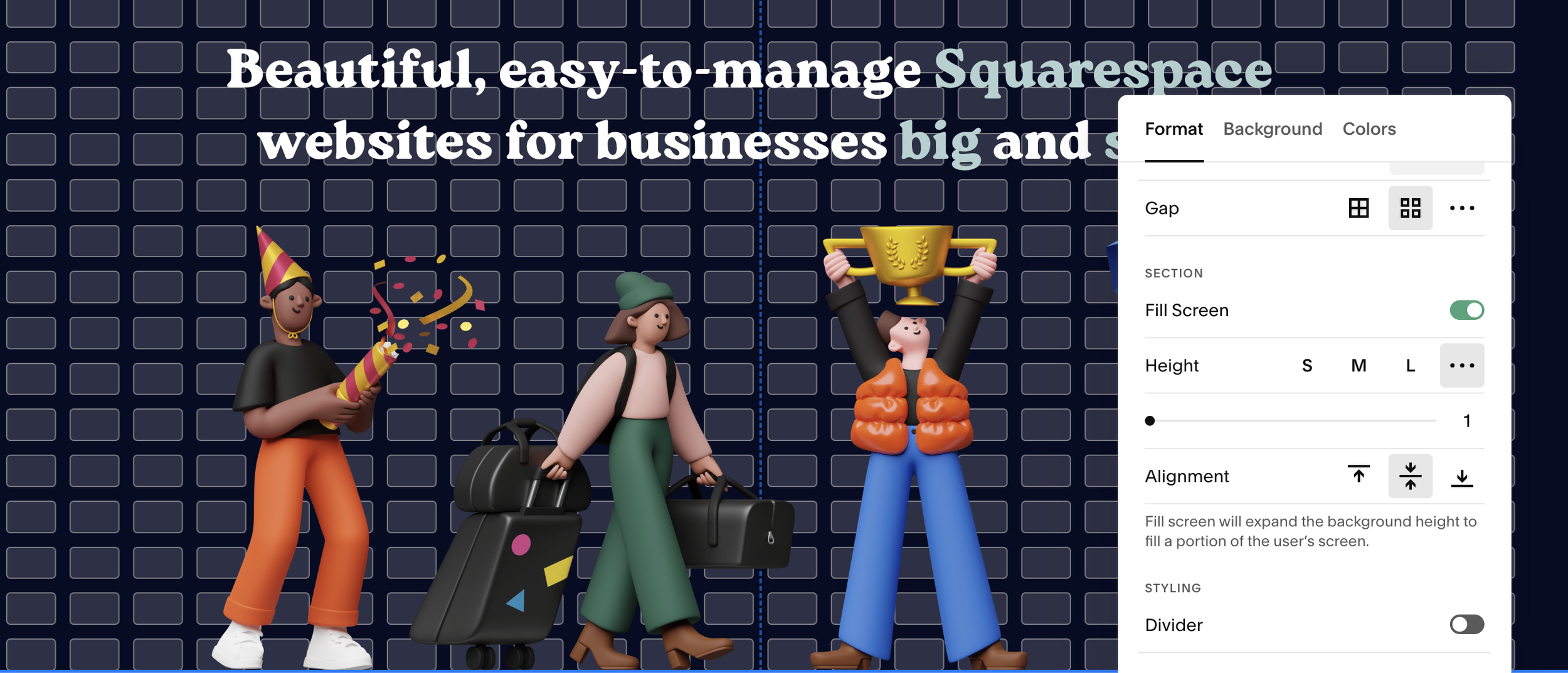Blending Psychology and Design: Crafting Effective and Intuitive Squarespace Websites
Good web design is about finding the right balance between how a website looks and how it works, while also understanding how people behave. By combining web design with psychology, we can create websites that are not only effective and easy to use, but are also engaging. By using psychological theories, designers can make websites more interactive. Here's a look at psychological theories and principles that can help create powerful web designs.
The Blink Test - Boosting Your Website's First Impression
'The Blink Test' concept is rooted in a study from Carleton University, and refers to a principle in web design that tests whether users can understand a website's content and offerings within fractions of a second - essentially in the blink of an eye.
In this blink of an eye, a website user rapidly evaluates a plethora of elements like structure, colours, spatial distribution, amount of text, and more. The user forms a swift initial impression which directly influences their willingness to stay or bounce.
Applying the Blink Test to Web Design
Creating a website that passes the Blink Test takes a lot of care and consideration. It involves thoughtful design, intuitive structure, and proper emphasis on your site's unique offerings. Here are key strategies to pass the Blink Test efficiently:
1. Clear Unique Selling Proposition (USP): Does your website communicate your brand's message effectively? A website visitor should quickly be able to decipher who you are, what you do, and how it benefits them. Top-quality designs, efficient copy, and the strategic placement of your USP can assist in capturing user's attention immediately.
2. Strong Visuals: Much about the Blink Test revolves around visual content. Attractive, high-quality images can transcend the barriers of rapid judgment. Users tend to remember clutter-free designs with bold images. Integrating relevant and engaging visuals can boost the immediate appeal of your site.
3. Easy-to-Read Text: Less is more! Bombarding your website with walls of text can be off-putting. Keep text minimal but coherent. Use bold headlines, bullets, lists and short paragraphs to ensure easy scanning.
4. Simple and Clean Design: Clean layout with a clear structure and ample whitespace makes a website attractive and quietens distraction. Simple navigation helps users find information quicker, boosting the probability of a longer stay.
5. Easy Navigation: A good design goes beyond aesthetics; it's about functionality, of which navigation is an integral part. The ease with which users can navigate through your site and find what they are looking for, influences their perception of the website and brand.
6. Effective Call to Action (CTA): The CTA is a pivotal factor for conversion. Ensure it stands out and tells users precisely what they are expected to do.
Treating the Blink Test as a core element of your web design practices can create websites that are instinctively likable, easier to navigate, and high on user engagement.
Gestalt Principles in Web Design: Creating Meaningful User Experiences
The Gestalt Principles are based on the idea that human visual perception views the world holistically rather than in individual parts. By organizing design elements methodically, layout becomes logical and symmetrical, making information accessible effortlessly. These principles help designers create pages that are easy for users to ingest and digest.
These principles were developed by a group of German psychologists in the early 20th century and are applied broadly in fields such as psychology, design, marketing, and more. Here's an overview of 5 key Gestalt Principles that an be applied to web design
1. Principle of Proximity: This principle suggests that objects that are close to each other tend to be perceived as a group. For example, you might perceive a row of trees as a group or line of trees rather than individual entities.
In website design, the Gestalt Principle of Proximity suggests that objects or elements close to each other are perceived as a unified group, helping users understand the correlation and categorization of information visually. By strategically grouping related content or navigation elements together, designers can create a website that's intuitive and effectively guides user behaviour, thus enhancing overall user experience
2. Principle of Similarity: According to this principle, the human eye tends to perceive similar elements in a design as a complete picture, shape, or group, even if those elements are separated.
The Gestalt Principle of Similarity in website design asserts that elements sharing similar visual characteristics, such as colour, shape, or size, are perceived as related or connected. By applying this principle, web designers can create visual consistency and well-structured content, making it easier for users to understand and navigate through the site, thereby improving usability and user experience.
3. Principle of Closure: This principle depicts the human mind's inclination to see complete figures even when part of the picture is missing. Our mind fills in the visual gap and perceives the figure as complete.
The Gestalt Principle of Closure can be showcased through parallax scrolling and hover reveal animations, where elements of a website are only partially visible but are intuitively completed by the user's perception, creating a seamless, engaging, and interactive user experience.
The Gestalt Principle of Closure influences logo design by cleverly arranging shapes or lines to create a complete image that people can easily identify, even if the parts of the design don’t explicitly come together.
A famous logo you are likely familiar with, the FedEx logo, cleverly applies the Gestalt Principle of Closure through the use of negative space between the letters 'E' and 'x,' contributing to the formation of an arrow. This design gives the audience a sense of completeness or "closure", as our minds naturally join the disconnected parts of the logo to recognize the arrow symbol.
4. Principle of Symmetry: The Gestalt Principle of Symmetry is a perception-based concept that indicates symmetrical objects provide a sense of balance and order, which is pleasing to the eye and leads to effective comprehension and interpretation.
The Gestalt Principle of Symmetry, when applied to website design, suggests that symmetrical layouts are inherently perceived as harmonious and well-ordered, improving the aesthetic appeal and overall user experience by creating a balanced and easy-to-navigate interface.
Today many web design trends are characterized by bold, and often asymmetric aesthetics and could seem at odds with the Gestalt Principle of Symmetry, which prioritizes balance and harmony in design. However, a well-planned websites can balance design trends while incorporating the principle of Symmetry through strategic arrangement of elements, harmonious colour pairing, and graphical balance to deliver compelling web experiences without compromising usability and intuitive navigation.
The grid system built into the Squarespace editor allows designers to easily apply the Gestalt Principle of Symmetry by providing a structured layout for content, thereby creating visually balanced and harmonious page designs.
5. Principle of Continuity: This principle indicates that the human eye follows paths, lines, curves, and favours smooth, continuous paths over disjointed ones.
The Gestalt Principle of Continuity suggests that we like to see smooth, connected lines rather than broken ones. In web design, this means creating a consistent look across the site, making it easier for users to understand and navigate.
Understanding these principles can assist in creating a more compelling and effective design, as they describe how visual images are perceived by the human mind. They're especially important in fields such as design, where the goal is to understand how to layout and structure visual information in a way that resonates most effectively with viewers.
Law of Prägnanz: Prioritizing Simplicity in Web Design
Another product of Gestalt psychology, the Law of Prägnanz emphasizes that users prefer simplified, readily recognizable designs. This principle underlines that less is more when it comes to design.
In web design, this principle can be applied by removing unnecessary elements and keeping designs clean and straightforward, ensuring that users can quickly and easily understand the information presented without being overwhelmed or confused.
Principle of Least Effort: Enhancing User Experience
The Principle of Least Effort or Zipf's Law, proposes that a person will naturally choose the path that requires the least cognitive effort. In other words, they want the easiest way to achieve their end goal.
The Principle of Least Effort states that users, when given a range of choices, prefer the path of least resistance or effort. In web design, this can be applied by creating an intuitive and user-friendly interface, with clear navigation and simple, straightforward tasks, thus minimizing the effort required for users to find information or complete actions on the website.
Incorporating this principle into the design process involves regular usability testing to ensure the navigation and user interface place minimal demands on user effort.
Conclusion
Understanding and implementing these theories and principles can guide web designers to create websites that are not just visually pleasing but also ensure a smooth, user-friendly experience. Efficient positioning of elements, systematic organization, carefully chosen options, simplistic approach, and designing for easy user navigation constitute the crux of effective web design.











